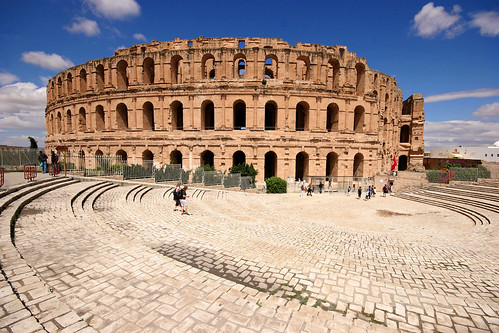
Tunisia and the Tunisian Republic is located on the north coast of the Mediterranean and African country is the most European of Africa. 40% of its surface is occupied by the Sahara desert with its golden sands and mysterious oasis, but has on its coast white beaches and small villages that remind us a little by Greece with its whitewashed houses and doors and windows painted a bright blue.
Tunisia has much to tourists as to the adventures in the great desert beaches, archeological ruins of Carthaginian and Roman times, cities, special, the chance to practice a variety of water sports and nautical in their spas and everything it means to be the meeting point of Europe and Arabic world, the great trading port of the Mediterranean.
Tunisia has a rich history and its main tourist destinations is the city of Hammamet, on the coast, with its medina, the souk, the port area which is ideal for walking, the Fort leaving only a handful of walls, the Grand Mosque in 1972, and the Museum Dar Hammamet and 15 km to Yasmine Hammamet is outside the tourist area 100% with beaches, resorts and luxury hotels.

Followed by cities in Tabarka, diving into the heart of Tunisia with its corals and crystal clear waters (near the border with Algeria), the green island of Djerba connected to the mainland by a Roman road with its beaches and mosques, and the beautiful Sidi Bou Said, a small village with whitewashed houses and famous white and blue holes. It is the best place to enjoy a friendly atmosphere, meet people and enjoy the cuisine of Tunisia.

If you want to see a memorial I recommend Jem, a Roman Amphitheater in Africa. This spectacular monument to accommodate over 35,000 spectators in the middle of a desert in Tunisia, which was the province of Africa.
The amphitheater of Jem in the middle of nowhere and the view we have the impression that the sky had fallen in the wrong place. However at the time, that area had a huge spread of olive trees that became a very flourishing trade in oil. In fact, the province of Africa was regarded as the granary of Rome.

Located 200 km from the capital, is considered the fourth largest Roman amphitheater in the world, after the Colosseum in Rome, Capua of Pozzuoli and of these three in Italy.
Its 148 meters long and 122 meters high and hosted gladiatorial fights of animals being silent witnesses stones wins and no doubt many deaths.
Its state of preservation is excellent despite the fact that part of its facade was demolished to build the city of El Jem. Fortunately, this symbol of Roman power was to survive to give us the option to watch in almost all its splendor.
In 1979 UNESCO declared this place as a World Heritage site and nothing can be discussed, since this is a very special place that must be protected with special care.
In the area of access to the amphitheater is highly recommended and entertaining visit the souvenir shops, where you can find all kinds of objects that serve as memory but not the classics. However, do not forget the bargain price.
One Response to “Traveling to Tunisia”
Leave a Reply
You must be logged in to post a comment.
marzo 17th, 2012 at 9:53 pm
[…] Traveling to Tunisia Journey between the sea and the desert Tunisia the desert country of mirages […]